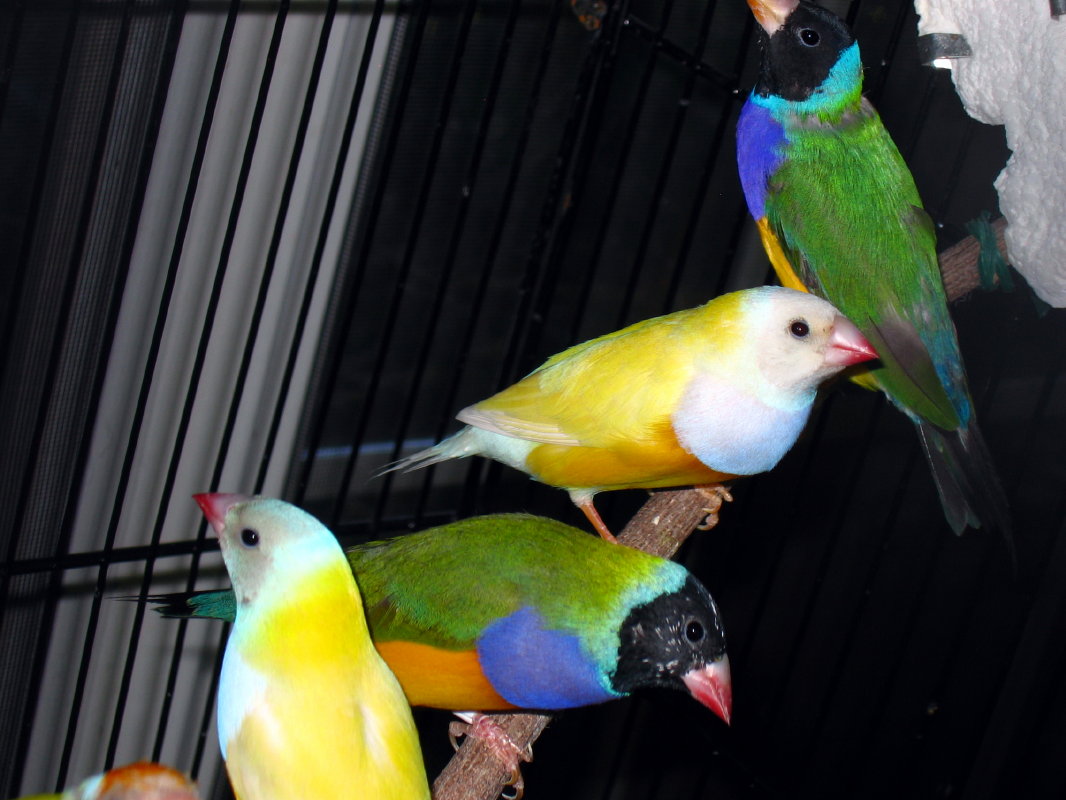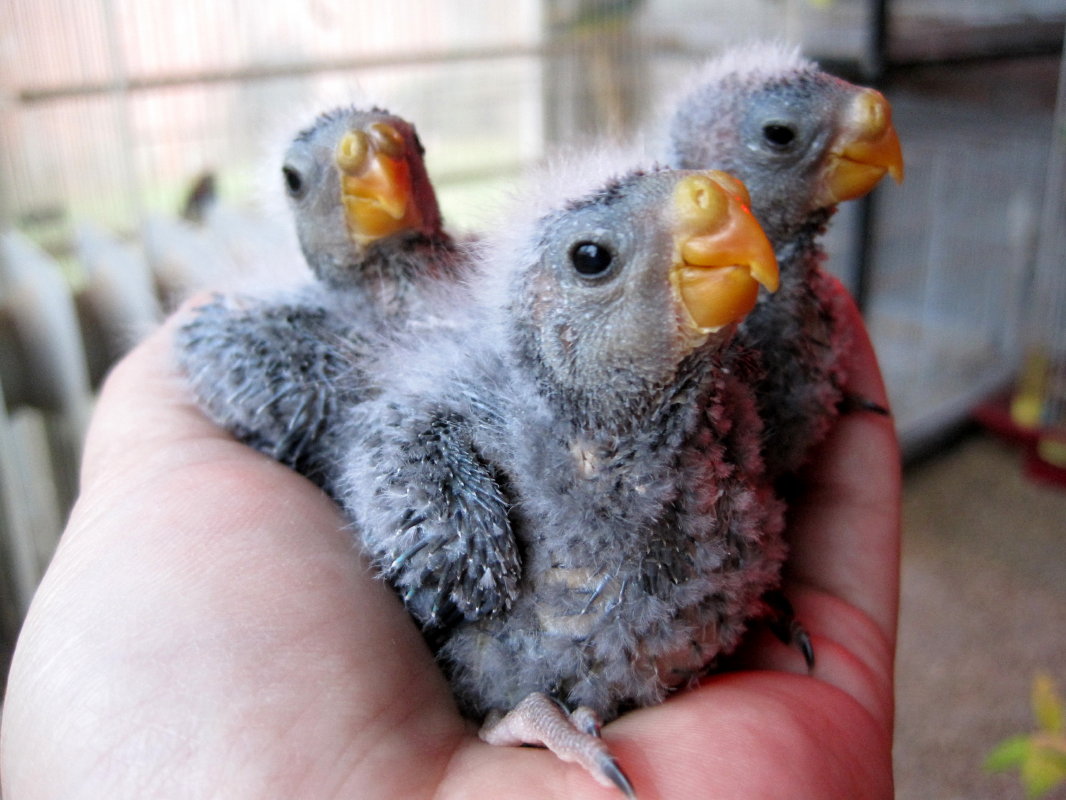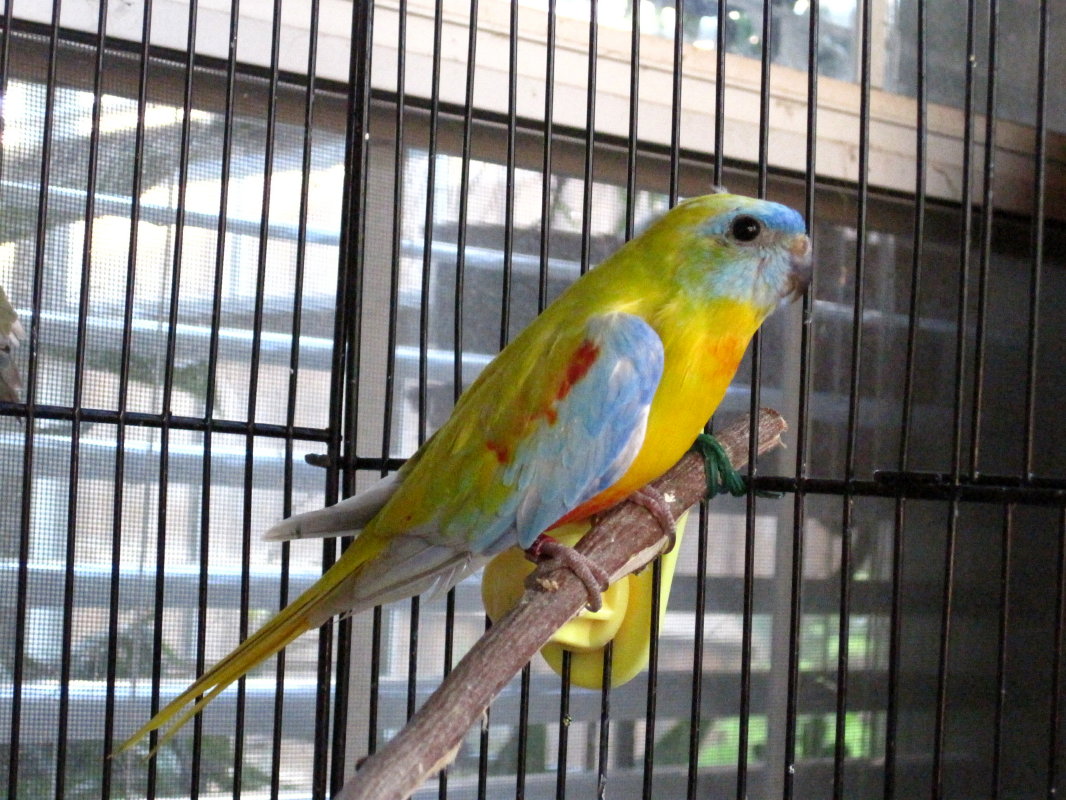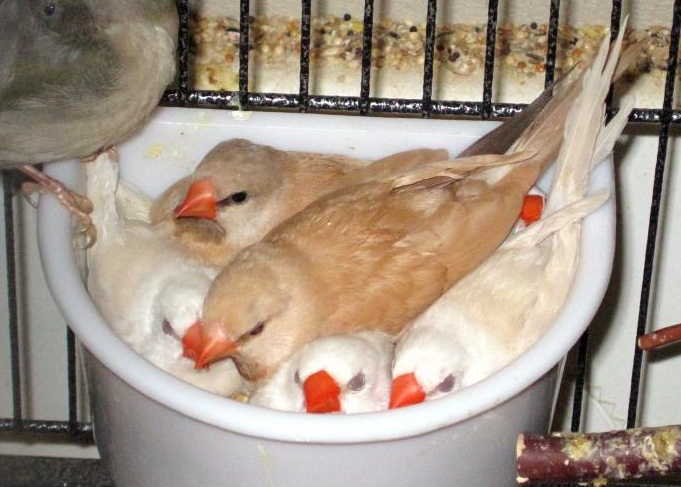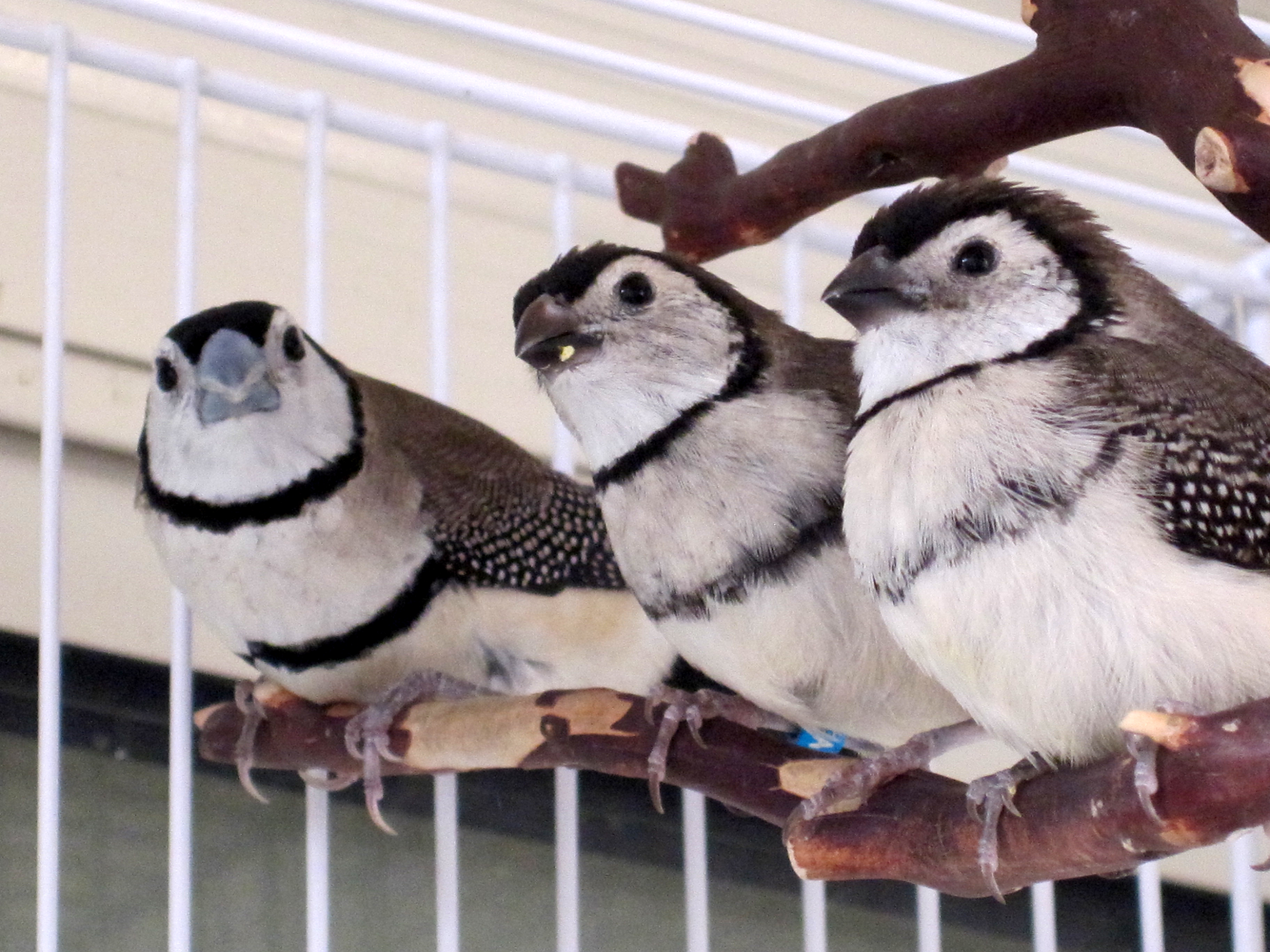There are plenty of great websites with information regarding the care of various species of finches and grasskeets. I would like to simply provide some basic information for the general care of these birds for non-experienced owners based on my own experience and hope to help prevent any major pitfalls that may occur. Please see my favorite links page for links to some excellent resources. I do not sell any of the products I recommend and has no financial interest in any of these products, but am simply relating from experience what works for me. Of course what works for me also changes from time to time. I will post any notable results from my "experiments".
Housing:
Both finches and grasskeets need a larger cage size. They do very well in aviaries, which may be outdoors as long as an out-of-the-weather and out-of-the-draft area is provided. For those of us without the benefit of an aviary, a large flight cage provides adequate amount of exercise. The width of the cage is more important than height and depth. At least 30 inches in width is needed. Minimum size for one pair of finch should be 30"x18"x18"; the larger the better. For grasskeets, because of their larger size compared to finches, I would recommend at least 30"x18"x30" per pair. Breeding cages can be smaller as long as the birds are allowed in the larger flights during nonbreeding times of the year. I have found waxbills like cordon blues or parrot finches really breed a lot better in larger flights. Many birds can slowly acclimate to both higher and lower temperatures, but sudden temperature change can be very stressful and induce illness. So when getting new birds, be sure to know what temperatures the birds are used to and allow them to adjust slowly to temperatures at your location.
Diet:
I feed both my finches and grasskeets essentially the same diet with a few differences.
First is a good quality seed mix. When I can not easily obtain a good commerical seed mix, I mix my own since I find it is less costly for me to buy different seeds from the local feed store (Southwest Feed Mills for those of you in the DFW area at www.southwestfeedmills.com/home.html) in bulk and mix together. For those of you who only own a few birds, it is probably much more cost effective to purchase quality seed mixes from the pet store or on-line resources. Some of the store-bought seed mixes has pellets which has vitamins. My birds never seem to touch these pellets, so I don't bother buying seed mixes that have these. I also do purchase harder to find seeds from on-line resources (Herman Bros. Pet Product at www.hermanbros-seed.com). The seed mix should include white millet, red millet, finch millet, canary seed, and oat groats. There should be also a small amount of rape seed, niger, and flax seeds. I will also purchase Japanese millet, siberian millet, rye grass seed, white lettuce seed, and black lettuce seed to add to the mix based on what some of the professional seed mixes have, when convenient. For my Java Rice finch, I provide some paddy rice in an individual dish, but the other finches and grasskeets also seem to enjoy trying it out. Hemp seed is another type of seed that has a lot of amino acids and fatty acids that are great for finches and grasskeets in moderate amounts during molting and breeding season - these I also mix with the paddy rice in a side dish - recently some concern over feeding too much Hemp seed will cause too much strain on the liver due to the high fat content has prompted me to drastically decrease the amount I feed - the commercial soft food I feed has small amount of hemp seeds, so I no longer give extra in individual cups. For grasskeets, they require safflower seed and small black oil seed sunflower - again, these I mix with the paddy rice and hemp seed in a side dish.
In addition to a quality seed mix, it also important to provide greens. I find it easier for the finches, especially, to cut various vegetables into small bite size pieces. I use a food processor for this purpose. Any vegetables can potentially be used, but no avocados, which are toxic to birds. There are many sites to look up what are potentially toxic to birds e.g. http://www.avianweb.com/toxicfoods.html. I simply use what is seasonally available, which usually includes carrots, cabbage, turnip greens, mustard greens, kale, collard green, romaine lettuce (any type of lettuce is ok, but iceberg lettuce does not have much nutritional value), corn, peas, etc. Birds can be very sensitive to pesticides, so if you are not using organic vegetables, be sure to wash carefully. Fruits such as apples can be added as well, but only my montane white-eyes and an occasional grasskeet like apples, and my canaries love oranges. I suggest avoiding making the vegetable mix too mushy. Just small bite size pieces are enough. Powdered vitamins can be sprinkled over the mix very easily. Recently, given time constraint, I've been giving the birds romaine leaves in large pieces as well as broccoli. So far so good.
Another important part of the diet is sprouted / chitted seeds. There are special seed mixes for sale for sprouting purposes, which I do use especially for live niger and other seeds that may be difficult to find fresh enough to sprount in regular seed mixes, but I also add additional white millet and canary seeds to these sprouting mixes. By sprouting the seeds, the amount of protein and vitamins are increased significantly. When sprouting seeds, however, it is important to use an anti-microbial agent to avoid bacterial, fungus, and yeast growing with the sprouts. I used to use KD water cleaner, but currently using Virkon S to sprout my seeds - the only difference is Virkon S is a lot less expensive than KD. GSE (grape seed extract), Aviclens, and even small amounts of bleach may be used. The seeds should be soaked with anti-microbial agent for 12-24 hours, rinse out with fresh water several times, drained as dry as possible, then left for 12-24 hours (depending on temperature). The seeds should be fed when roots are just showing - so called chitted seeds. This is the stage for the sprouting seeds which has the most protein. Waiting longer when the roots are longer leaves more carbohydrates than protein for the birds to eat. Most birds love eating the chitted seeds, so it is also a good vehicle to mix in supplements and soft food for picky eaters.
Spray millet can be fed - most birds love this stuff. It is mainly carbohydrates with little other nutritional value so normally should be fed in moderation as treats. I do tend to offer this daily to breeding, weaning, and sick birds. Give in moderation for parents feeding babies so that they will not only feed spray millet to the babies but will also feed chitted seeds and soft food. Weaning babies and sick birds find it easier to eat spray millet.
Supplements:
Everyone has to decide what supplement system to use. This depends on if your birds on inside or outside i.e. how much UV/full spectrum light they get as well as what kind of foods they eat. For breeding birds, almost always, additional calcium and vitamin D is needed. There are many supplements that can be put into the drinking water to add Ca and vit D e.g. Calcium Plus. This ensures against egg binding and make sure the egg shells are good and strong. Other good Ca supplements are crushed egg shells and oyster shells. These can be purchased from various stores/on-line sources. If you want to make your own crushed egg shells for your birds, make sure to either boil or bake the shells fully to kill all pathogens.
Depending on what kind of diet your birds are eating, a complete vitamin supplement may be added to the diet periodically. I prefer to sprinkle Feather Fast onto my green salad when the birds are molting to provide some additional vitamins and minerals - this particular vitamin powder gets sticky when encountering wet things, so sprinkling over soaked/sprouted seeds tend to make a sticky mess that then hardens as the mixture dries. The green salad gets eaten fairly fast, preventing this problem. I also do add some vitamin supplements which contains some iodine into the drinking water a couple days out of the week to make sure even the really picky eaters gets some vitamins (Ioford, Dufoplus, and Megamix).
I also like to provide granulated charcoal, granulated kelp, and Herb Salad for the birds free of choice. The birds really enjoy eating these. The charcoal provides minerals and helps them digest and absorb any toxins in their diet or produced by bacteria when they are sick. The kelp (they don't like eating powdered kelp) had lots of good amino acids, minerals, and iodine. Herb Salad can be used by birds as needed to self treat what ails them.
Many people make their own egg food to provide additional protein for their birds especially during breeding and molting periods. This is fairly easy to do and many recipes are available online. I am always afraid of using fresh egg food especially in hotter weather due to concerns of spoilage since I am not always able to remove the egg food within a few hours of feeding. Therefore, I try to add fresh boiled eggs to commercial dried egg/protein food to make the mixture as dry as possible, which I mix in with the dry seed mix or chitted seeds. I have been trying Mike Fidler's Complete Soft Food and Frisky Finch's Premium Baby Hatchling and Young Bird Food Mash as well as Miracle Meal. For the sake of decreasing cost, I have recently tried out Higgins Proteen 25 and Petamine. So far, no significant differences. Currently trying a mixture of tried soft foods inspired by the Delmar Gouldian Recipe and also trying to add fresh eggs to the dried mix to see if this improves the health of the birds any. So far the Delmar Gouldian Recipe is working out as well as any of the previously listed commerical soft foods. I am also adding additional high protein powder (Soya Musca from www.glamgouldians.com), Avian Trio, Insect Basics, flax seed oil, cod liver oil, and probiotics to the egg food mix.
Illness/Medications:
Everyone is always concerned about air sac mites especially in gouldian finches. Some sources report air sac mites to be of little concern in general in U.S. gouldians and prophylactic treatment is of little benefit if the gouldians are not already infected. Since I do add new birds from outside sources now and then, I prefer to treat all new birds during the quarantine period of at least 2-4 weeks depending on who I get them from and how the birds look. I also choose to treat for mites with S76 before the breeding season and before the molting season to prevent any significant infection during the periods of stress when latent infections can worsen with lowered immune system. I also worm the birds with Worm Away about twice a year. I do keep some avian antibiotics such as Doxycycline, Ronivet, Nystatin and CocciCare around just in case of infections - finches tend not to show any sign of illness (puffed up, sleeping all the time, lethargic, panting, sitting at bottom of the cage, wet vent) until they are on their last legs, so being able to treat them empirically until you can get them to the vet can be very helpful. When birds are sick, the best thing to do is provide additional heat in form of a heat lamp, additional humidity (especially in egg-bound birds) in form of a damp towel draped over the cage, and water with additional electrolyte which you may need to hand feed to the sick birds if they are too sick to even drink (pedialyte can be used if you don't have something like NV powder). This being said, I still suggest having a good avian vet available since sometimes it can be difficult to figure what the bird is sick from, so doing a fecal exam at the vets can be very useful to figure out what is the correct treatment.
Prevention is the best way to "treat" infections for finches since most of the time we catch them too late. Keeping their environment and food/water containers clean is very important, as is keeping food/greens clean and unspoiled. Good nutrition produces strong birds with stronger immunity which are less likely to get sick. I also give mine Avian Trio, which has bee pollen, royal jelly, and bee propolis; this is a natural supplement which is meant to boost immunity (often used by humans as well) - unfortunately, my birds seem to hate this product even if sprinkled into veggies, so I've been trying to sneak it in with their soft food. Also trying out probiotics.
Fostering for finches:
This can be a controversial topic for breeders. I prefer to save any potential life if I can, which is the reason I will use society finches for fosters. Of course parent raising is the best, but on the occasions that fertile eggs/hatchlings are abandoned, and I have no other pairs of the same species to foster under, I will use societies. Some societies are carriers of certain bacteria which they can transmit to the babies under their care, causing death in fledgelings/juveniles. Therefore, if you choose to use societies as foster, try to obtain societies from a clean line that is also a good foster line (some societies are better fosters than others, but they are in general great parents). I have never had any significant problems from losing fledglings fostered under societies, so I believe I have a clean line. I've also gotten societies from finch breeders who use their societies as fosters; these are more likely to be clean and from good foster lines. Best foster set up is 2-3 male societies, but I've found any combination of societies can foster. If you don't intend to breed the societies, then keeping only males cuts down on society eggs that can get in the mix. Give your societies either fake finch eggs or infertile eggs one at a time until 4-5 eggs starting around the same time as your breeding pair is starting to lay eggs. This helps to keep the breeding cycle the same between your breeding pair and the fosters. Feed your fosters the same good diet as your breeders to ensure the babies get a good diet. Societies tend to be less picky eaters, so it's not difficult to make sure the abandoned babies get a good diet. I have not had problems with fostered babies imprinting on the societies and not able to breed appropriately with their own species because I pull the fostered babies as soon as they are weaned and place back in the same flight as their parent species.
